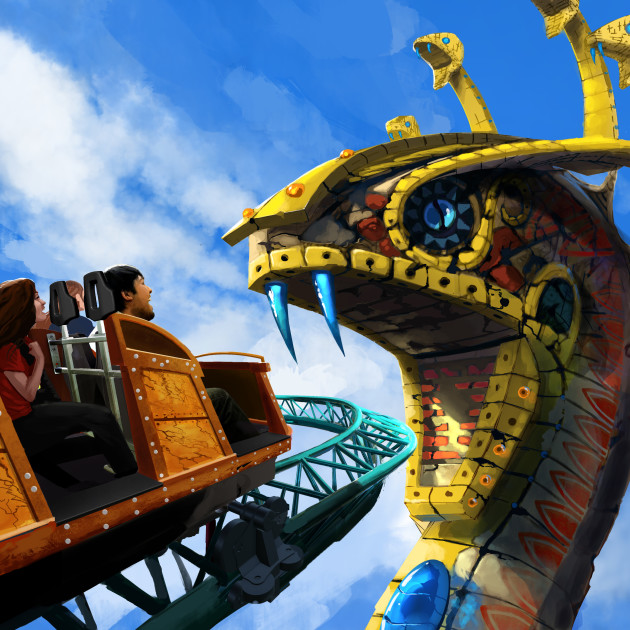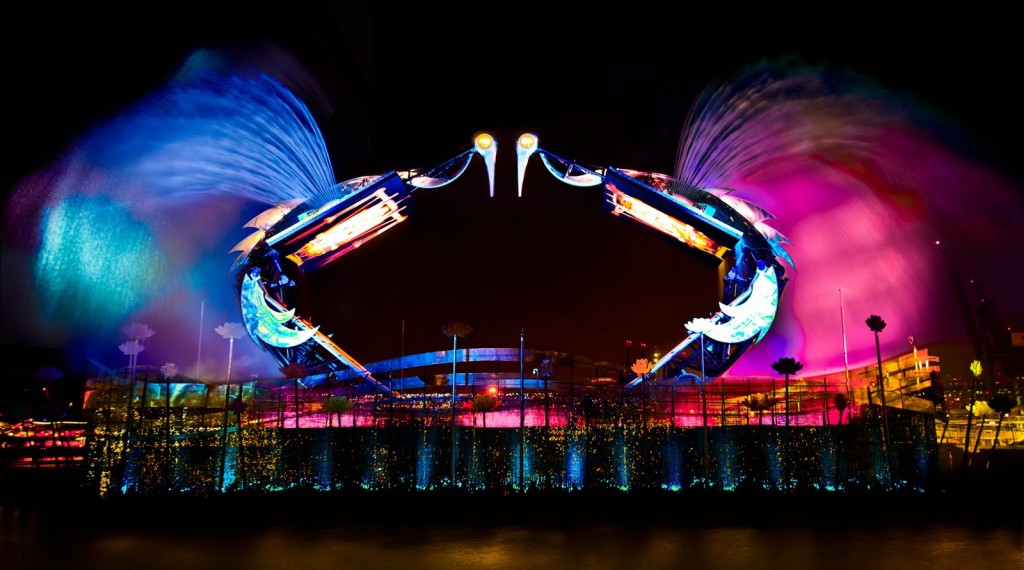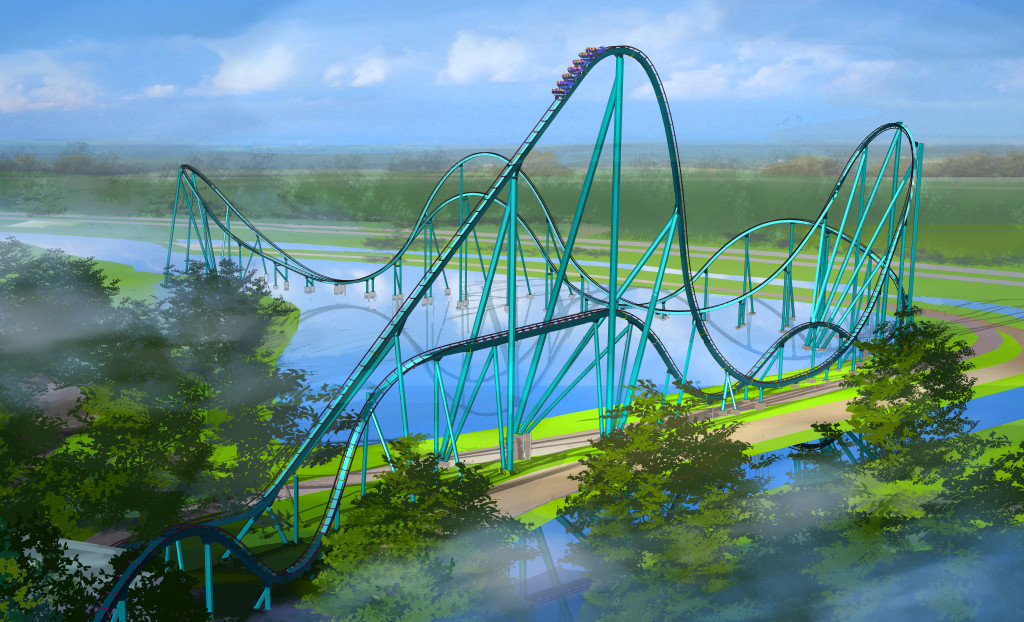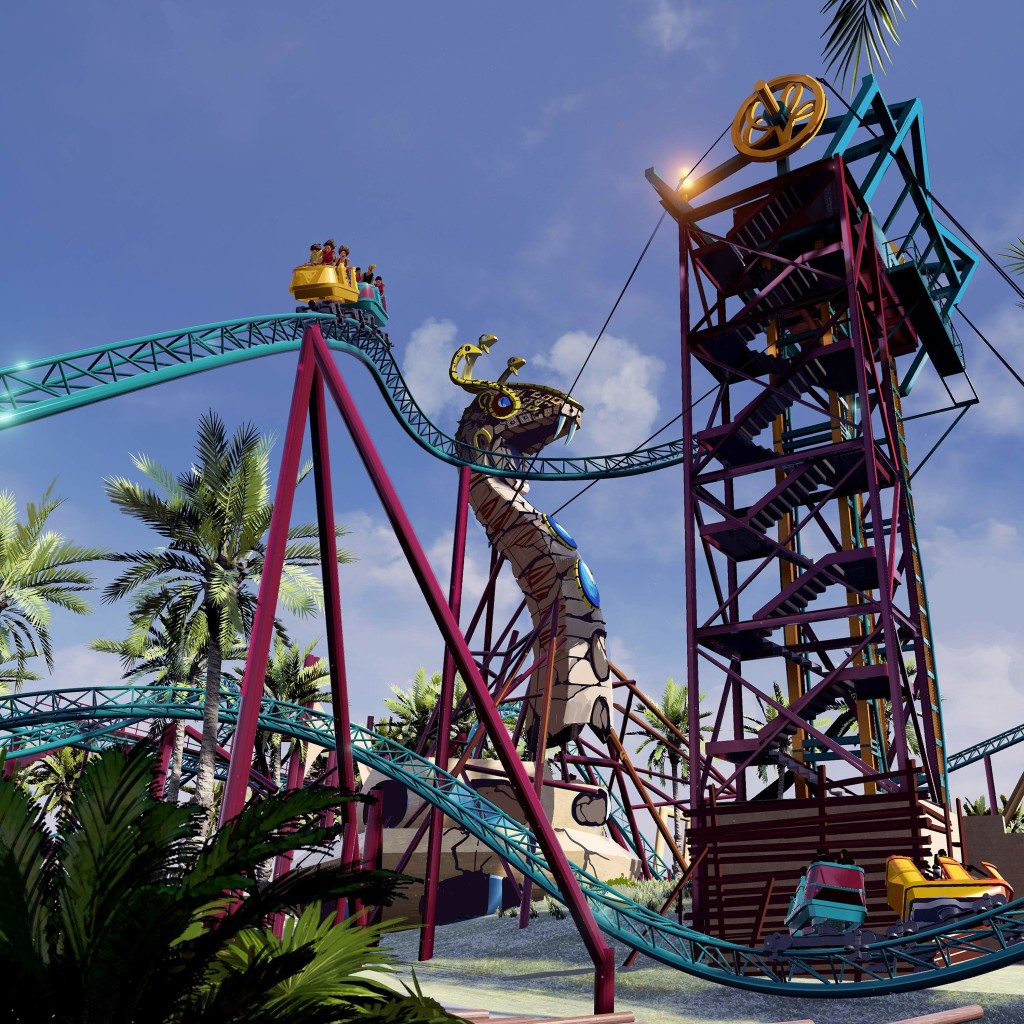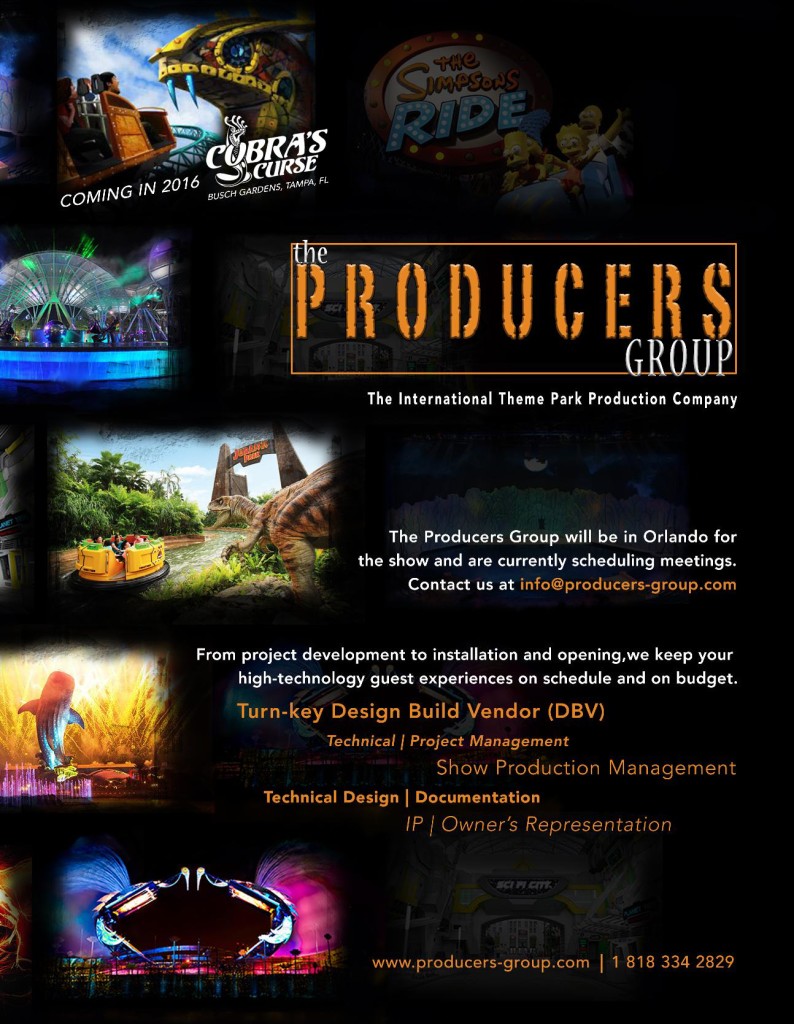The Producers Group brings collaborative power to theme park projects
by Judy Rubin
Since The Producers Group (TPG) founding in 2011 by co-CEOs Bob Chambers and Edward Marks, the company has become best known for helping to realize some very large-scale, one-off attractions at resorts and theme parks in Asia, including the famous Crane Dance designed by Jeremy Railton. TPG was even the lead in a recent Los Angeles Times article about Southern California theme park companies bringing their specialized know-how to Asian markets.
[dropcap color=”#888″ type=”square”]B[/dropcap]ut TPG’s wide range of production and production support services are also in demand stateside for high-tech rides and attractions. The company was recently recruited by SeaWorld Parks & Entertainment to help create two new themed roller coaster experiences in Florida, as part of the external team working with the in-house creative arm. For Cobra’s Curse™, a new, family oriented spin coaster at Busch Gardens® Tampa, TPG is providing show production services, continuing through the construction phase. For Mako™, the hypercoaster at SeaWorld Orlando, TPG provided technical and production management services in the concept design phase. Both rides open in 2016.
It is an axiom of the visitor attractions industry that re-investment is key for any operator to stay competitive. SeaWorld Parks & Entertainment is introducing these new ride experiences at a busy time for Florida tourism development. Merlin Entertainments and Crayola have entered the field. Universal and Disney continue to expand with new rides and projects. Tourism numbers continue to climb.
“We stand up against the competition with a highly differentiated product,” says Brian Morrow, senior director attraction development and design, SeaWorld Parks & Entertainment. “Cobra’s Curse™ and Mako™ are new entries into SeaWorld’s ever evolving stories and experiences. Not only are they going to be fantastic and unique thrill rides, but also rich educational experiences. “Our differentiator in attractions is that SeaWorld Creative Studio creates Experiences that Matter.”
Regarding TPG’s involvement, Morrow said, “We always seek the best talent that can fulfill our business needs. TPG has worked with us successfully on some past attractions, and were the right fit for the style of attraction and type of work we are doing now.”
Internal/External team dynamics
Pairing in-house resources with outside creatives and vendors is one of the ways park operators endeavor to keep their offerings competitive and their project process efficient while building the brand. It’s seen as a business model that’s good for the project, the park, the industry, and the guest. For example, on Cobra’s Curse™, TPG is providing show production and technical coordination with their scope touching media, lighting, sound and audio. TPG staff on the project includes Rob Palmer (associate producer), Andrew Rubio (project manager) and Doug Storm (technical director). Others on the distinguished external team include PGAV (attraction and facility design), Colette Piceau (creative producer/show writer) Melody Matheny (graphic design), Nate Mitchell (show set design), Nassal (rockwork and plaster), ThemeWorks (graphics and props), exp (electrical engineering), MACK Rides (ride manufacturer) and PCL (general construction).
They answer to SeaWorld’s internal team headed by Brian Morrow (creative director for the project), Jeff Hornick (project manager), Mike Denninger (overseeing ride engineering and install) and Mark Rose (local project executive at Busch Gardens Tampa). SeaWorld’s education and zoological teams are also involved.
“Bringing in top outside specialists is good for our company,” says Morrow. “It allows us to be most efficient, to find the best talent for individual projects and build the best possible team. We can change teams out by project, based on expertise, skillset, personality. It allows us to be fast, nimble, and to make the best choices at any given time in the marketplace and for the type of project. In addition to skills and experience, I look for a personality mix that will provide the most productivity and healthy relationships. In terms of creativity and innovation, the collaboration brings in the best ideas to help strategically accomplish our goals. In order to protect the brand, we integrate everyone into the project team so that they feel they have a stake. People tend to protect what they create.”
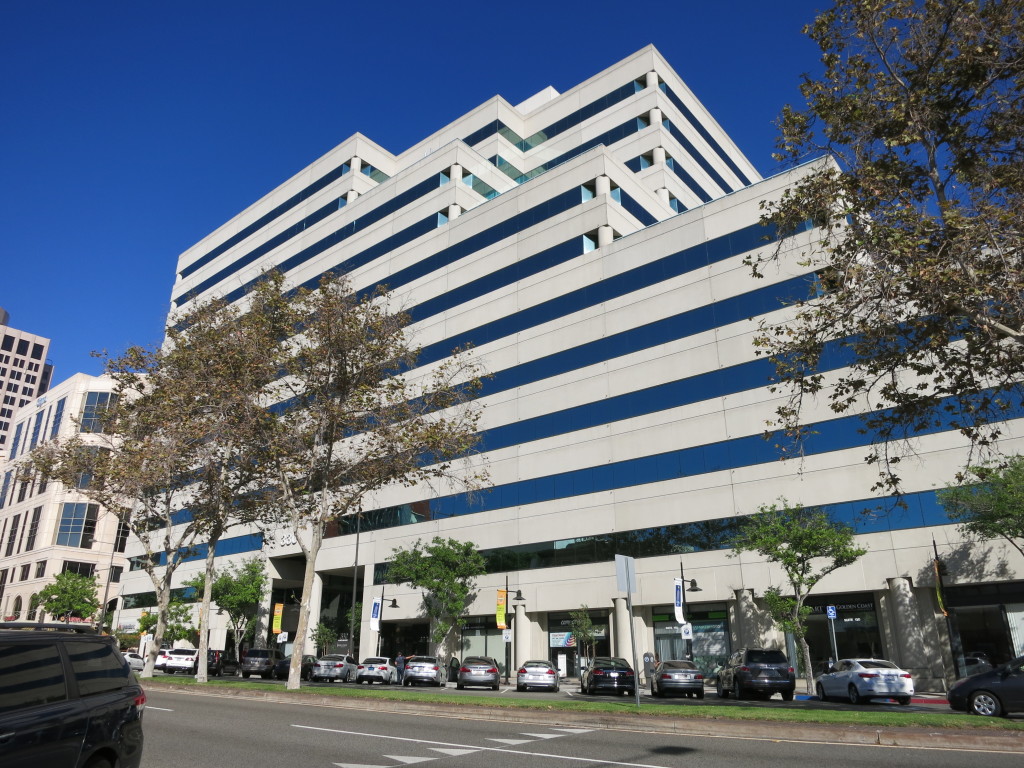
Photo courtesy of The Producers Group
“Drawing upon an outside team, a client gets the advantage of all the collective experience of the members of that team,” said Chambers, “from work done on other projects and in other parts of the world. The client gains a broader base of experience and instantaneous momentum. And speaking from the viewpoint of a company that specializes in this kind of collaboration, we’re highly motivated to do well because we want to do it again for the same client in the future.”
“As a design-build vendor, TPG has accumulated just the kind of experience a client needs from an external team,” said Marks. “Having gone through all the steps on past projects with a lot of show and ride in them enabled us to build an experienced and dedicated staff. We’re in a position to quickly recognize the stages of a project, so that whatever stage we are brought in, we can quickly get into sync and identify what needs to be done to get successfully to the grand opening.”
TPG’s resources
The internal/external team model is used on projects of all kinds, including museums as well as parks and attractions of all types and sizes. Established operators such as SeaWorld can strategically augment their existing staff; newer operators can enter the business more quickly. Seasoned creatives and techs take what they’ve learned and use that know-how to grow the industry in new ways and new directions. “It helps keep things fresh and competitive,” said Chambers. “The guests who come to see the attractions get a better experience; the operator makes more money, having created a better product; the bar is raised, and the whole industry benefits. You get more smiles all around.”
There’s constant competition to be the company that wins the bid to help build a great new attraction that raises the bar. To keep its own position as an international contender, TPG maintains offices in Los Angeles and Shanghai, and fulltime staff expert in a range of technical disciplines including project management, show production, technical direction, CAD, lighting design, AV and show control, show action and special effects. Several months ago Brian Paiva, a top business development executive, also joined the company.
In addition to their core fulltime staff, TPG will staff up further for particular projects. For instance, when they need a creative designer or creative director, they draw on their network to find the right fit for the job.
TPG principals see their production-centric, design/build culture as ideal for projects in today’s markets. They’ve used wisdom and experience gained in both East and West to inform their process. “We are simultaneously protecting the creative vision and the client’s interests, and helping to ensure a steady workflow,” said Marks. “Many attractions industry developers, owners, and operators are looking for turnkey solutions. They want a process that combines overall project management and owner’s representation. We have carved our niche as the company that does this.”
Creative show programming
TPG’s signature approach to show programming was founded on the expertise of Marks and of project manager Chris Homsley, gained in theatrical and live show production. Marks describes it as “a little Olympics ceremonies, a little Cirque du Soleil, a little TPG. Chris and I both come from a place where creative programming is sacred,” he said. “From dark rides to spectaculars to media based attractions, show programming is where all components come together. We treat all the tech disciplines like creative disciplines – as if they were performers on the stage – so they are all represented in the rehearsal and with the ability to adjust. We design all elements with the ability to adjust and tweak, and bring everyone together in the same place and at the same time under a very controlled scheduled series of events, and dial in all these individual elements in concert with other elements.”
Marks described how the process was applied on Crane Dance. The unique spectacle at Resorts World Sentosa consists of two giant, animatronic cranes that evoke the eponymous birds. Each precisely programmed mechanical bird sports a huge video screen on its chest, and wings made of water streams. “The water wings are one of the most complicated things we’ve ever done, and the finished result is transparent to guests – a sure indication of its success. They’re streams of salt water and they’re moving in close proximity to the video screen. The video screen has video water that syncs with the real water. We light the water theatrically, and it is constantly changing and moving, and the video water on the screens changes as well. The elements chase one another, and the only way to make something like this look real, to get it right is to do it in the space.”
“It’s like staging a play or choreographing a dance,” said Homsley. “The tech assets and creative assets have to work together.”
“The result is a very integrated show – and that’s our strength: an integrated show,” said Marks. “It’s something that has to be specifically scheduled and budgeted for, and the product is always much better for it. It makes creative directors happy because they don’t have to be so locked down. It makes owners happy because they get to dial in the show the way they imagined it at the beginning.”
TPG at IAAPA
The Producers Group is bringing eight staff to the 2015 IAAPA Attractions Expo in Orlando. The company is a Silver level sponsor of the Asia-Pacific Breakfast, and is setting up a room in the convention center for private business meetings during the show. To set up a meeting, contact Judd Nissen, [email protected]. • • •
Making Mako™
The Mako shark is one of the fastest swimming sharks known. “It swims long distances and breaches out of the water because it is going so fast,” said Morrow. And so the Mako™ hypercoaster was designed be the tallest, fastest and longest coaster in Orlando, and to move in ways that evoke its namesake creature. “The ride vehicle is a shark,” said Morrow. “The guest gets to feel what it’s like to be a Mako shark.” As a hypercoaster, Mako™ will give riders a lot of “air time” (the feeling of weightlessness or floating) but no inversions. “It’s what people love, and it makes it repeatable,” said Morrow. The storytelling and theming will include the use of media, lighting and special effects that sometimes envelop the shark/vehicle, as well as scenics. In addition to being a thrill ride, aspects of the experience will educate riders to appreciate the shark, inform them about challenges sharks face in the wild, and what they can do to make things better.
SeaWorld’s internal team includes Morrow (creative director/project manager), Michael Spencer (project manager), Mike Denninger (ride design and install), and Jeff Hornick (regional director for the company’s attractions in Florida). As with Cobra’s Curse™, SeaWorld’s educational and zoological teams are involved. In addition to TPG, the external team includes PGAV (design), Luce Group (lighting design), ThemeWorks (design/build of all scenic elements, theme paint and graphics), exp (electrical engineering), Erik Essig (creative production), and Pro Sound (audio design). Ride manufacturer: B&M.
Creating Cobra’s Curse™
In keeping with its ancient Egypt archeological mystery story, and making the most of the park’s existing terrain, the Cobra’s Curse™ adventure will raise riders 70 feet high on a vertical lift where a cobra statue of equal height will look back at them, fangs bared, and deliver the “curse” that will set them on their spinning journey, sweeping along a track above the park’s Serengeti Plain. There will be detailed theming from the facades through the queue to the load station and ride.
Brian Morrow described Cobra’s Curse™ as a pet project and promised that it would do some things unique to a spin coaster. The ride environment will boast Busch Gardens Tampa’s first indoor themed queue area, extensively themed as an archaeological site, with special effects and some real snakes. As they ascend in the lift, guests learn that the dig site has awakened the curse of an ancient Egyptian snake deity, and their wild ride begins. The theming and storytelling details and effects continue through the ride.


